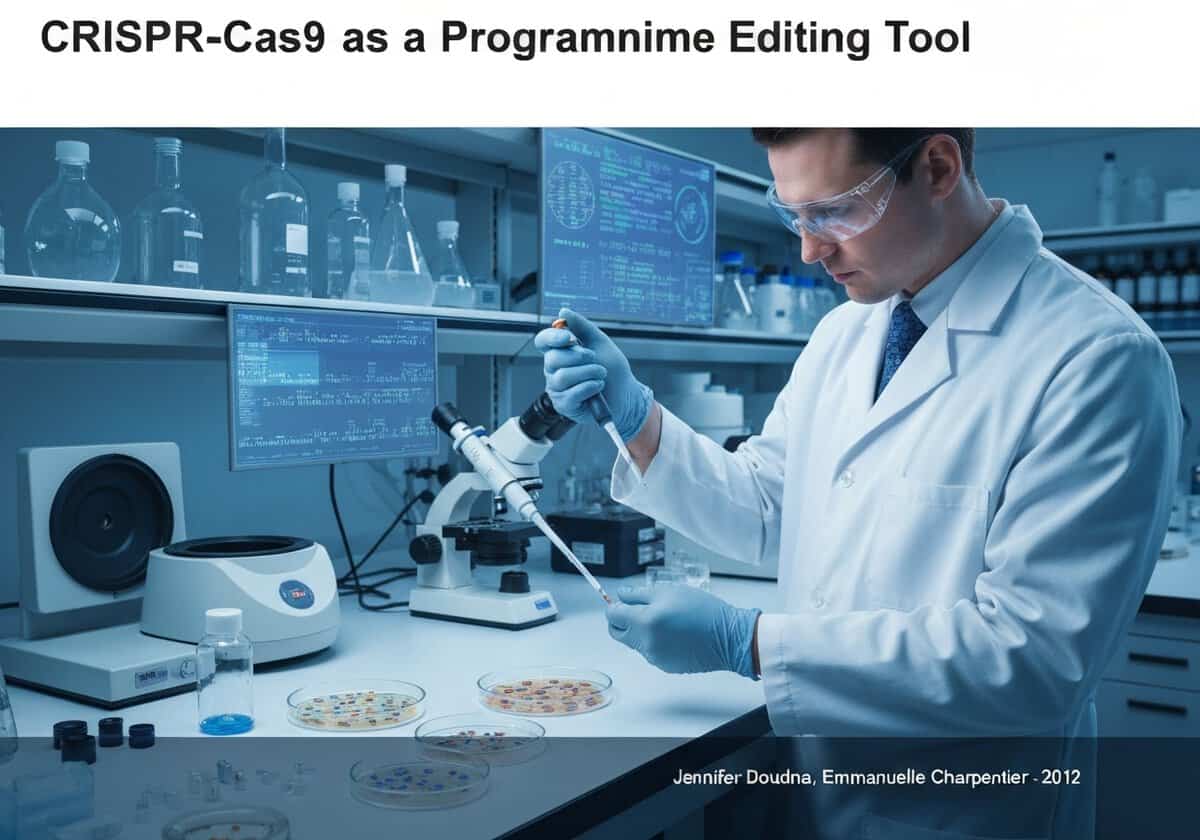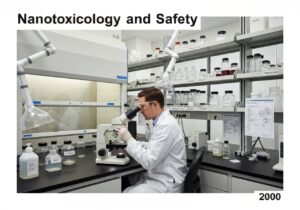The natural CRISPR-Cas9 system was repurposed into a revolutionary gene-editing technology. By fusing the two essential RNA components (crRNA and tracrRNA) into a synthetic single-guide RNA (sgRNA), scientists created a simple two-component system. This sgRNA directs the Cas9 nuclease to any desired DNA location to create a precise double-strand break, which can then be repaired by the cell to introduce targeted mutations or insert new genetic material.
CRISPR-Cas9 as a Programmable Gene Editing Tool
- Jennifer Doudna
- Emmanuelle Charpentier

The transformation of the CRISPR-Cas9 bacterial immune system into a universal tool for genome editing was a landmark achievement in molecular biology. The key insight was recognizing its potential for being reprogrammed. In its natural form, the Type II system uses three components: the Cas9 protein, a crRNA that contains the targeting sequence, and a tracrRNA that is crucial for crRNA maturation and Cas9 activation. The Doudna and Charpentier labs demonstrated that this system could be simplified. They engineered a single chimeric RNA, which they termed a single-guide RNA (sgRNA), by linking the 3′ end of the crRNA to the 5′ end of the tracrRNA with a synthetic hairpin loop. This sgRNA retained all the necessary functions of the dual-RNA system.
This simplification was revolutionary because it meant that to retarget the Cas9 nuclease to a new DNA site, one only needed to synthesize a new sgRNA with a different 20-nucleotide guide sequence. This made the technology remarkably easy to use, cheap, and scalable compared to previous editing methods like Zinc Finger Nucleases (ZFNs) and TALENs, which required complex and costly protein engineering for each new target. When the Cas9-sgRNA complex is introduced into a cell, it locates its target DNA sequence and creates a double-strand break (DSB). The cell’s natural DNA repair machinery then takes over. The error-prone Non-Homologous End Joining (NHEJ) pathway often introduces small insertions or deletions (indels), effectively knocking out the gene. Alternatively, if a donor DNA template is supplied, the more precise Homology-Directed Repair (HDR) pathway can be used to insert new sequences or correct mutations.
Tipo
Interruzione
Utilizzo
Precursori
- discovery of the natural crispr-cas9 mechanism in bacteria
- identification and functional characterization of the tracrrna
- understanding of cellular dna repair mechanisms (nhej and hdr)
- prior gene editing technologies like zfns and talens, which established the principle of targeted double-strand breaks
- advances in rna synthesis and genetic engineering techniques
Applicazioni
- gene therapy for genetic disorders like sickle cell anemia and beta-thalassemia
- development of disease-resistant crops and livestock
- creation of animal models for human diseases
- functional genomics research to study gene function (gene knockouts)
- development of rapid diagnostics for infectious diseases
- cancer immunotherapy (e.g., car-t cell therapy)
Brevetti:
- US8697359B1
- US10000772B2
- EP2771468B1
Potenziali idee innovative
Livelli! Iscrizione richiesta
Per accedere a questo contenuto devi essere un membro di !Professionals (100% free)!
DISPONIBILE PER NUOVE SFIDE
Ingegnere meccanico, responsabile di progetto, ingegneria di processo o ricerca e sviluppo
Disponibile per una nuova sfida con breve preavviso.
Contattami su LinkedIn
Integrazione di componenti elettronici in plastica e metallo, progettazione in base ai costi, GMP, ergonomia, dispositivi e materiali di consumo di medio-alto volume, produzione snella, settori regolamentati, CE e FDA, CAD, Solidworks, Lean Sigma Black Belt, ISO 13485 in ambito medico
Stiamo cercando un nuovo sponsor
La tua azienda o istituzione si occupa di tecnica, scienza o ricerca?
> inviaci un messaggio <
Ricevi tutti i nuovi articoli
Gratuito, no spam, email non distribuita né rivenduta
oppure puoi ottenere la tua iscrizione completa -gratuitamente- per accedere a tutti i contenuti riservati >Qui<
Contesto storico
CRISPR-Cas9 as a Programmable Gene Editing Tool
(se la data non è nota o non è rilevante, ad esempio "meccanica dei fluidi", viene fornita una stima approssimativa della sua notevole comparsa)
Principi di invenzione, innovazione e tecnica correlati














